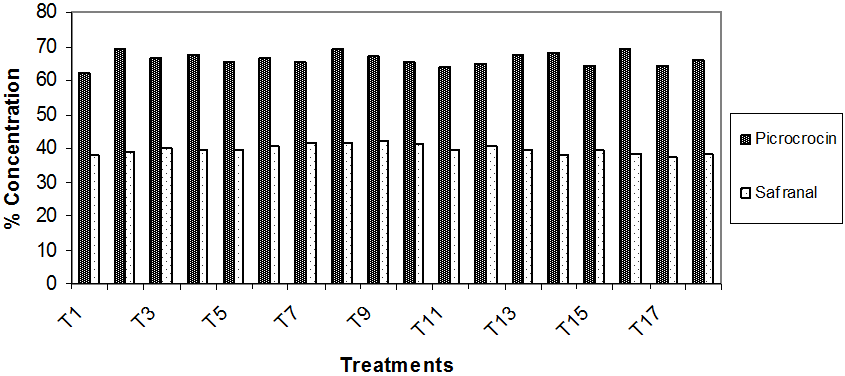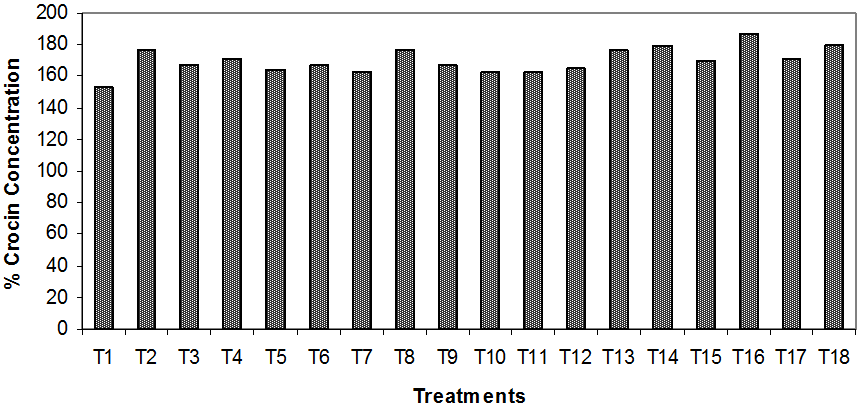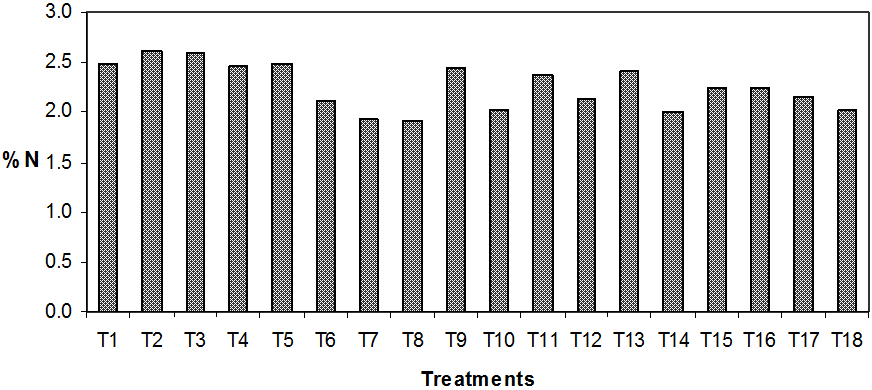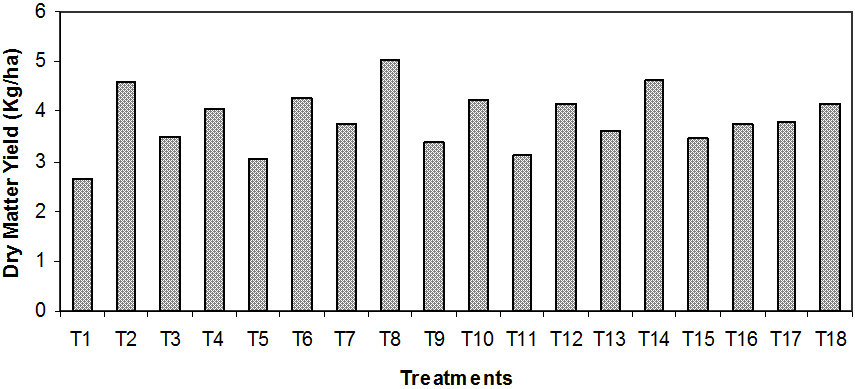Research Article
Volume 2 Issue 4 - 2018
Application of Manure Fertilizers and Micronutrients on the Quantity and Quality of Saffron Crop planted in the Khorasan Razavi Province
Scientific Research Staff of Soil and Water Department, Agricultural Research, Education and Natural Resources Center of Khorasan Razavi Province, Agricultural Research, Education and Extension Organization, Mashhad, Iran
*Corresponding Author: Rezaeian Saeed, Scientific Research Staff of Soil and Water Department, Agricultural Research, Education and Natural Resources Center of Khorasan Razavi Province, Agricultural Research, Education and Extension Organization. Mashhad, Iran.
Received: November 25, 2017; Published: March 06, 2018
Abstract
The effect of zinc and iron micronutrients and manure fertilizers, and also their interaction effects were investigated on the yield and quality of saffron flower. On the basis of data analysis by ANOVA (1383-1384) showed that the effect of animal manure alone obtained the Maximum yield at a rate of 7.35 Kg/ha. The minimum yield was obtained at the M1 Zn1 Fe1 level. The results showed that, since the experimental area soils have relatively high pH and EC, and high bicarbonate values of irrigation water, the soil iron and zinc nutrients can not be absorbed by the plants. Therefore, we have to reduce the soil pH and EC values, and create a balanced condition for the optimum plant nutrient uptake. The quality of saffron (Color, Flavor and Fragrance) was also analyzed by UV spectrophotometer.
Keywords: Saffron Quantity; Iron and Zinc fertilizers; Saffron Quality
Introduction
Saffron plant "Crocus Sativus Linn" is a perennial plant, and triploid (2n = 24). The three stigmas along with about 5 cm. long style, when dried constitute the pure saffron of commerce (Sampathu., et al. 1984). Mostly, because of its medicinal, fragrance, flavor and coloring properties, and components such as; crocin, picrocrocin, and safranal are known as the source of second derivatives of the plant (Hosseini, 2003).
Today, Iran is the major supplier of saffron to the world market, and it is a strategic plant in the south of Khorasan region. Saffron cultivation in this province is about 50000 ha, which amounts to 98.3% of the whole Iran saffron cultivation. The yearly saffron production in Khorasan province is about 160 Ton. Which equals 98% of the saffron production in Iran (Kafi., et al. 2002). At present time, the production efficiency in saffron farms of Iran is very low, and in average is about 5 Kg/ha. Therefore, one of the main solution for increasing efficiency, is the use of existing sources, and increasing the yield per unit area, with the emphasis on different basis such as; conservation of environmental pollution, increasing soil fertility and economics in the long run, and optimum use of organic and inorganic fertilizers. Every day increasing world interest is the use of " fragrance, color, flavor, and medicinal" sources with plant roots, have opened a broadened horizon for export of Iranian saffron (Moosavi and Mehrabzadeh, 2003).
Materials and Methods
This experiment was conducted in Gonabad experiment station, as a factorial experiment in a randomized complete block design with three replications since fall of 1380, for four years. The experimental treatments included;
(Zn0 = 0, Zn1 = 30, Zn2 = 60) and (Fe0 = 0, Fe1 = 100, Fe2 = 200) Kg/ha, (M0 = 0, M1 = 25) Ton/ha.
(Zn0 = 0, Zn1 = 30, Zn2 = 60) and (Fe0 = 0, Fe1 = 100, Fe2 = 200) Kg/ha, (M0 = 0, M1 = 25) Ton/ha.
A composite soil sample, and a water sample was also taken separately before planting, and analyzed in the laboratory. The amount of N,P,K, fertilizers were given each year according to the soil testing recommendations by soil and water research institute. This was done on the basis of 100 Kg/ha urea and potassium sulfate, and 50 Kg/ha triple-super-phosphate. Also all the other agronomical practices were done based on the recommendations given for the Gonabad region experimental station (Rezaian and forouhar, 2004). The treatments were fertilized according to the experimental design. The experimental area was about 2000m2, also it was irrigated before planting and the main fertilizers, including the treatments were broadcasted and incorporated into the area, based on the soil test recommendation and the experimental design.
Results and Discussion
On the basis of data analysis done by the ANOVA (82-83) the interaction effects of iron and zinc sulfates, and manure on the saffron yield at α = 5% probability level was significant, only the manure at a rate of 25 Ton/ha in comparison to control treatment at the α = 1% level was also significant. Data analysis by ANOVA (1383-1384) showed that the effect of animal manure alone obtained the Maximum yield at a rate of 7.35 Kg/ha. The minimum yield was obtained at the M1 Zn1 Fe1 level. Investigation of data analysis on quality characteristics of saffron by the manure at the M1 = 25 Ton/ha level, showed that the picrocrocin and crocin concentrations compared to control treatment were increased by 3.32% and 4.84% respectively. The safranal concentration, and the % N decreased by the 0.15% and 7.66% respectively, for dried stigmas. Different rates of iron sulfate effected the quality of dried saffron, at (Fe1 = 100 Kg/ha), the maximum picrocrocin and crocin concentration levels were in the order of 66.85% and 170.97% respectively. The maximum safranal concentration and % N were obtained at (Fe = 0) level in the order of 4.16% and 2.34%, respectively.
The use of different rates of zinc sulfates had also a noticeable effect on the quality characteristics of saffron, such that at the (Zn2 = 60 Kg/ha) level, the max. picrocrocin and crocin concentrations were in the order of 66.56% and 177.24% respectively. The maximum safranal concentration and % N were obtained at the control level treatment in the order of 4.96% and 2.46% respectively. The interaction effects of manure, iron sulfate, and zinc sulfate fertilizers had a noticeable effect on saffron quality as shown (Table 1). The effect of different chemical fertilizers and manure on saffron quality, which had produced saffron with high quality, are shown in the figures attached (Figure 1, 2, 3, 4). The results shown are indicating that overall, the positive effect of use of manure, iron sulfate, and zinc sulfate on increasing amount of picrocrocin and crocin concentration, and decreased amount of % N, and safranal concentration. Meanwhile, there is a positive effect in yield increase obtained in the dried saffron stigma. In the case of optimum fertilizer use, in addition to the yield increase, there is the possibility of producing high quality crop.
| Treatments | Picrocrocin | Crocin | Safranal | N % |
| M0Fe0 | 65.05 | 164.45 | 39.46 | 2.28 |
| M1Fe0 | 68.64 | 177.5 | 39.40 | 2.17 |
| M0Fe1 | 65.87 | 168.05 | 40.69 | 2.43 |
| M1Fe1 | 67.45 | 173.62 | 39.64 | 2.24 |
| M0Fe2 | 64.43 | 165.65 | 38.80 | 2.34 |
| M1Fe2 | 65.75 | 171.12 | 39.75 | 2.10 |
| M0Zn0 | 64.61 | 161.24 | 39.20 | 2.52 |
| M1Zn0 | 67.76 | 171.41 | 39.71 | 2.40 |
| M0Zn1 | 65.31 | 164.77 | 40.98 | 2.24 |
| M1Zn1 | 66.39 | 168.49 | 40.94 | 2.02 |
| M0Zn2 | 65.43 | 172.14 | 38.77 | 2.27 |
| M1Zn2 | 67.69 | 182.34 | 38.13 | 2.09 |
| Zn0Fe0 | 64.14 | 164.42 | 41.60 | 2.55 |
| Zn0Fe1 | 67.00 | 168.85 | 41.77 | 2.53 |
| Zn0Fe2 | 66.02 | 165.37 | 40.13 | 2.30 |
| Zn1Fe0 | 67.14 | 170.16 | 39.82 | 2.24 |
| Zn1Fe1 | 66.28 | 165.32 | 39.79 | 2.26 |
| Zn1Fe2 | 65.54 | 164.76 | 39.10 | 2.21 |
| Zn2Fe0 | 67.86 | 178.01 | 38.39 | 2.24 |
| Zn2Fe1 | 66.72 | 178.34 | 38.44 | 2.09 |
| Zn2Fe2 | 65.11 | 175.37 | 37.87 | 1.93 |
Table 1: Mean comparison of interaction effects of manure, iron sulfate and zinc sulfate on quality crarteristics of saffron.
References
- Hosseini KD. “Investigation of saffron effective composition "color, fragrance, and flavor" in different regions of Khorasan”. In "3rd national symposium of saffron", Iran, Mashhad (2003):
- Kafi M., et al. “Saffron production technology, and processing, 1st print”. University of Ferdowsi press. Mashhad. Iran (2002):
- Moussavi M and F Mehrabzadeh. “Investigating the "color, fragrance, and flavor" changes during storage. In "3rd national symposium of saffron”. (2003): 393-398.
- Rezaian S and M Forouhar. “The effect of N fertilizers (Urea, S.C.U) with manure on the saffron yield. Acta Hort 650, ISHS Proc. 1st IS on saffron. In"eds:J.A. Fernandez and F. Abdullaev"”. (2004): 201-205.
- Sampathu SR., et al. “Saffron (Crocus Sativus L.)- Cultivation, processing, chemistry and standardization”. Critical Reviews in Food Science and Nutrition 20.2 (1984): 123-157.
Citation:
Rezaeian Saeed. “Application of Manure Fertilizers and Micronutrients on the Quantity and Quality of Saffron Crop planted in
the Khorasan Razavi Province”. Innovative Techniques in Agriculture 2.4 (2018): 449-453.
Copyright: © 2018 Rezaeian Saeed. This is an open-access article distributed under the terms of the Creative Commons Attribution License, which permits unrestricted use, distribution, and reproduction in any medium, provided the original author and source are credited.

































 Scientia Ricerca is licensed and content of this site is available under a Creative Commons Attribution 4.0 International License.
Scientia Ricerca is licensed and content of this site is available under a Creative Commons Attribution 4.0 International License.